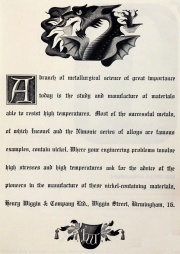Henry Wiggin and Co
"The oldest established firm of nickel and nickel silver manufacturers" in Britain (1919)[1]
of Wiggin Street, Birmingham 16 and Grosvenor House, Park Lane, London.
of The Nickel Works, Holly Lane, Erdington
1832 Charles Askin first made nickel silver in Birmingham. He went in to partnership with Henry Merry at Sherbourne Street.
1834 He formed a new partnership with Brooke Evans at George Street - Evans and Askin
1848 They moved to new premises beside the Birmingham Canal
When Charles Askin died, Henry Wiggin became a partner
1862 On the death of Brooke Evans, Wiggin took over the metal-refining business, which dominated the nickel industry in Britain. Evans's two surviving brothers remained partners.
1870 After the last of the Evans brothers died, the business became Henry Wiggin and Co., manufacturers of nickel alloys.
1877 Recruited a German chemist, Gustav Adolph Boeddiker, who worked on improvements to the original refining process and kept the business at the forefront of technical advances.
1880 Wiggin passed the management to Alfred Smeaton Johnstone, whom he had taken into partnership.
1892 The firm was converted into a limited company. Wiggin retained the chairmanship.
1892 Henry Wiggin's eldest son, Henry Arthur Wiggin (1852–1917), was managing director of the company from 1892 to 1899.
1905 Death of Henry Wiggin
Up to 1905 metal rolling was contracted out to companies like Rollason but Wiggins purchased them and moved the rolling plant mill to the Ladywood Works in Wiggins Street
1912 Exhibitor at the Non-Ferrous Metals Exhibition at the Royal Agricultural Halls[2].
1922 Acquired by Mond Nickel Co
1928 Mond Nickel was acquired by International Nickel Company of Canada[3].
1931 Acquired an extrusion, tube and rod-drawing mill at Glasgow.
1937 Nickel alloy manufacturers.[4]
1939 See Aircraft Industry Suppliers
1945 Advert. Monel nickel-copper alloy.
1950 The Ministry of Supply erected works at Hereford works to manufacture Nimonic heat-resisting alloys.
1956 The company purchased the Hereford works and developed plans for the modernization and concentration of all the company's production facilities.
1960 Advert. High nickel alloys.
1966 J. S. McFarlane became director.[5]
1968 Testing equipment for their alloys at the Hereford works.[6]
1975 Main UK manufacturing subsidiary of International Nickel Company of Canada.
1975 Supplier of high nickel blanks to Daniel Doncaster and Sons of Sheffield for making into turbine blades[7].
21st century: continued to operate as Special Metals Wiggin Ltd.
See Also
Sources of Information
- Mechanical World Year Book 1945. Published by Emmott and Co of Manchester. Advert p204
- Mechanical World Year Book 1960. Published by Emmott and Co of Manchester. Advert p204


























